For contrast imaging, you’ll get ideal results with Gram staining paired with phase contrast microscopy, negative staining with uranyl acetate (pH 3.5) for electron microscopy, and fluorescent dyes like FRET pairs (CFP/YFP) for fluorescence microscopy. Acid-fast staining works exceptionally well for mycobacteria visualization. Consider combining techniques like India ink with safranin for complex structures or using essential dyes for live cell imaging. The right staining technique dramatically enhances the specific cellular features you’re targeting.
The Fundamentals of Contrast Enhancement in Microscopy
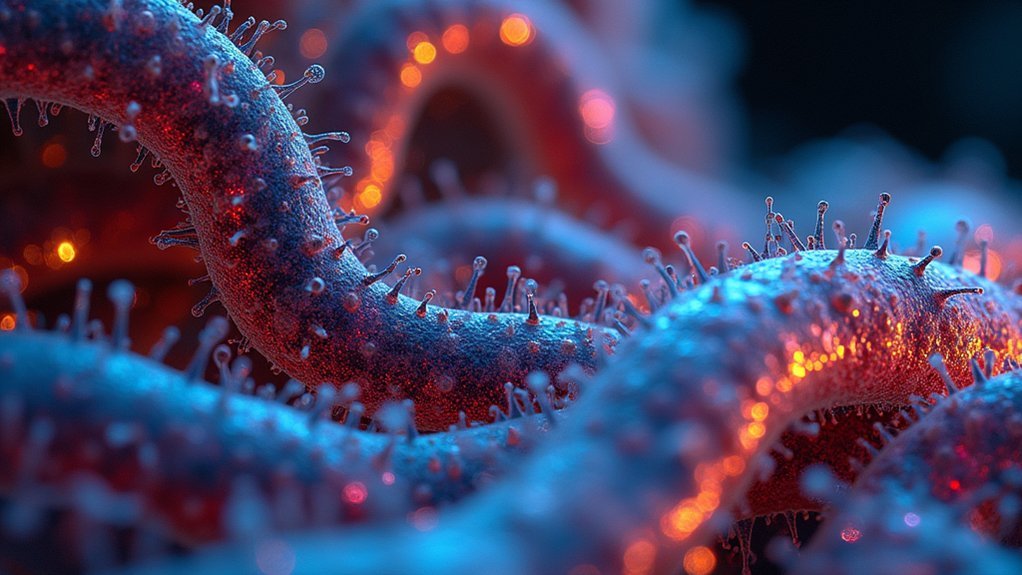
While our eyes can readily distinguish objects in the natural world, microscopic specimens often lack inherent contrast, presenting a major challenge for researchers. You’ll find that contrast enhancement techniques transform these nearly invisible specimens into clearly defined structures.
Phase contrast microscopy, pioneered by Frits Zernike, converts phase variations in thin specimens (5-10 micrometers) into visible amplitude differences without staining.
For living cells, DIC microscopy creates impressive three-dimensional images using polarized light and Nomarski prisms.
When staining techniques are required, your choice matters considerably. Gram staining distinguishes bacterial types by differential coloration, while other stains target specific cellular structures.
The relationship between your contrast method and staining approach is critical—each enhances particular features and addresses different research questions.
Gram Staining: Applications With Phase Contrast
Although bacterial cells often appear transparent under standard brightfield microscopy, the combination of Gram staining with phase contrast creates a powerful diagnostic tool. When you apply this differential staining technique, you’ll notice how contrast is generated between Gram-positive and Gram-negative cells based on their cell wall composition.
| Step | Purpose | Visual Effect in Phase Contrast |
|---|---|---|
| Crystal Violet | Primary stain | Enhances cell boundaries |
| Iodine | Mordant fixation | Increases dye retention |
| Alcohol | Decolorization | Differential removal based on cell type |
| Safranin | Counterstain | Creates red contrast in Gram-negative cells |
Phase contrast microscopy amplifies these differences by utilizing refractive index variations, allowing you to simultaneously observe staining characteristics and cellular morphology. You’ll see purple Gram-positive cocci or rods distinctly separated from pink Gram-negative bacteria, providing immediate identification benefits.
Negative Staining Techniques for Improved Visualization
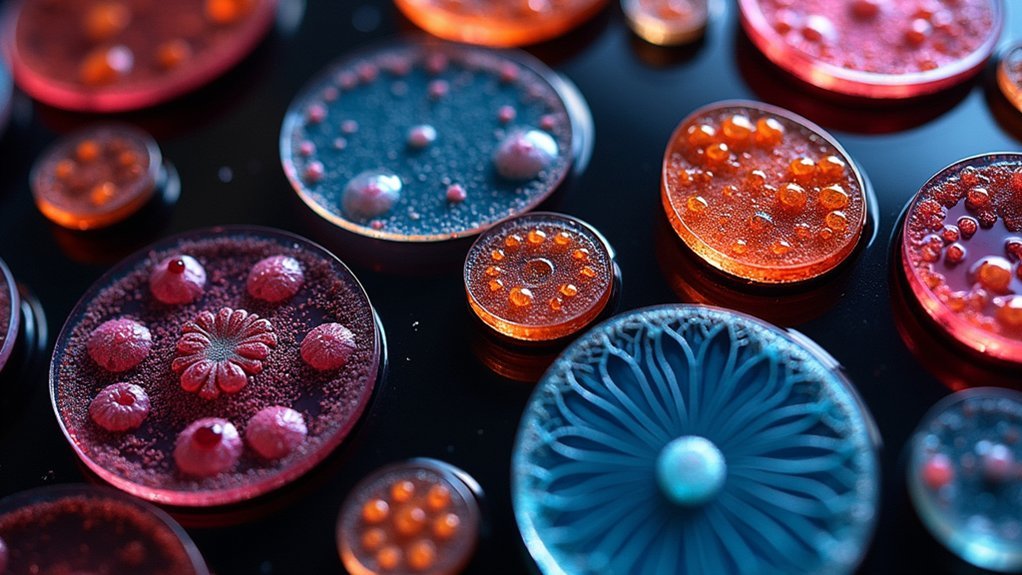
In negative staining applications, you’ll find uranyl acetate particularly valuable for highlighting virus particles and bacterial flagella due to its electron-dense properties.
Phosphotungstic acid offers complementary benefits, providing excellent contrast for cellular membranes while preserving delicate biological structures intact.
These reagents enable you to visualize specimens without altering their natural state, making them essential tools for both routine microscopy and advanced ultrastructural research.
Uranyl Acetate Applications
Three key properties make uranyl acetate (UA) indispensable for negative staining in electron microscopy. Its high atomic weight provides exceptional electron density, creating superior contrast imaging of cellular structures. You’ll achieve excellent results at pH 3.5, where uranyl ions effectively bind to DNA while minimizing nonspecific reactions.
| Property | Application Benefit |
|---|---|
| High electron density | Enhanced visualization of fine structures |
| pH sensitivity | Excellent binding at 3.5 for nucleic acids |
| Solution versatility | Alcoholic solutions for faster penetration |
| Lead citrate compatibility | Improved membrane and protein complex staining |
| Precipitation control | Consistent results with proper handling |
When using UA for negative staining, you’ll notice dramatically improved resolution of biological specimens. Choose alcoholic solutions when you need high contrast results quickly, but remember to handle solutions carefully to prevent those problematic yellow crystalline precipitates.
Phosphotungstic Acid Benefits
Phosphotungstic acid (PTA) stands as another powerful tool in your negative staining arsenal, complementing uranyl acetate with distinct advantages for specific applications.
When you’re examining viruses, bacteria, or cellular organelles, PTA creates an electron-dense dark background that dramatically enhances contrast without penetrating or altering your specimens’ structures.
You’ll find PTA particularly valuable in electron microscopy, where its heavy metal composition increases electron density to reveal fine structural details of biomolecules. The technique provides exceptional visualization of cellular structures with minimal preparation time, making it ideal for time-sensitive research.
For best results, consider combining PTA with other negative stains like uranyl acetate. This complementary approach maximizes contrast and improves overall visibility, giving you thorough insights into your specimens’ morphological characteristics.
Fluorescent Dyes and Their Role in Contrast Imaging
When working with fluorescent dyes for contrast imaging, you’ll need to select compatible FRET pairs that maximize energy transfer between donor and acceptor molecules.
You can enhance your imaging clarity by employing multi-channel spectral separation techniques that distinguish between different fluorophores simultaneously present in your sample.
For extended imaging sessions, you should prioritize photobleaching resistant dyes that maintain signal intensity over time, allowing for continuous observation of dynamic cellular processes without significant loss of contrast.
FRET Pairs Compatibility
How do scientists achieve perfect molecular visualization at the nanoscale? The answer often lies in Fluorescence Resonance Energy Transfer (FRET) pairs, which function as molecular rulers in contrast microscope systems.
When you’re selecting FRET pairs for biological imaging, compatibility between donor and acceptor fluorescent dyes is vital—their spectral overlap determines energy transfer efficiency.
Common pairs like CFP/YFP and GFP/mCherry provide high contrast visualization of molecular interactions within the 1-10 nm range. You’ll achieve best results when considering not just spectral compatibility but also the relative orientation and quantum yield of your fluorophores.
The specific excitation and emission wavelengths of well-matched FRET pairs minimize background noise while maximizing signal detection. For dynamic cellular imaging, choose pairs based on their brightness, photostability, and compatibility with your imaging system.
Multi-Channel Spectral Separation
The remarkable power of multi-channel spectral separation lies in its ability to visualize multiple cellular targets simultaneously with distinct colors.
You’ll achieve superior image contrast by selecting fluorescent dyes with non-overlapping emission spectra, such as fluorescein and rhodamine, which highlight different cellular components with exceptional clarity.
When working with complex samples, spectral unmixing algorithms help eliminate background noise by separating overlapping signals, revealing true biological features.
- Near-infrared (NIR) dyes penetrate deeper into tissues while reducing autofluorescence
- High quantum yield dyes produce brighter signals for improved contrast in multi-channel imaging
- Strategic dye selection guarantees compatibility with your microscope’s filter sets
- Proper spectral separation allows for quantitative analysis of multiple targets in a single acquisition
Photobleaching Resistant Dyes
Nearly all conventional fluorophores suffer from photodegradation during extended imaging, but photobleaching resistant dyes like Alexa Fluor and Cy dyes represent a revolutionary advancement in contrast imaging.
These robust fluorophores maintain their brightness and signal intensity even after multiple excitation cycles, allowing you to capture clear images throughout your experiments.
When tracking cellular events in fluorescence microscopy, you’ll find these dyes invaluable for time-lapse imaging of live cells.
Their exceptional photostability guarantees consistent contrast without significant signal loss over time. You can also leverage their wide color range for multiplexing, visualizing multiple targets simultaneously with enhanced detail.
Differential Interference Contrast With Special Stains
While conventional microscopy techniques often struggle with transparent specimens, differential interference contrast (DIC) microscopy transforms nearly invisible cellular details into striking three-dimensional images with remarkable clarity.
You’ll find this technique especially valuable when examining live cells, as it detects subtle refractive index differences without harming your specimens.
To maximize visual contrast when using DIC microscopy:
- Combine DIC with fluorescent dyes to highlight specific cellular components while maintaining the 3D relief effect
- Use DIC when examining unstained tissue sections to minimize halo artifacts that typically obscure fine structures
- Apply specialized stains selectively with DIC to enhance contrast of delicate organelles
- Consider DIC with staining for morphological studies where traditional staining might alter specimen integrity
This powerful combination lets you visualize structural details in biological samples without compromising their natural state.
Acid-Fast Staining Methodology for Mycobacteria

Because traditional Gram staining fails to penetrate the waxy, mycolic acid-rich cell walls of mycobacteria, acid-fast staining techniques have become essential for identifying these clinically significant pathogens.
When you’re working with suspected tuberculosis samples, you’ll start with a heat-fixed smear flooded with carbol fuchsin. After decolorization with acid-alcohol, mycobacteria retain the pink dye while non-acid-fast organisms appear blue with counterstain.
| Method | Heat Required | Applications |
|---|---|---|
| Ziehl-Neelsen | Yes | Standard TB diagnosis |
| Kinyoun | No | Rapid screening |
| Modified Kinyoun | No | Environmental samples |
This staining procedure serves as a critical diagnostic tool in clinical microbiology, enabling you to quickly identify potential mycobacterial infections before cultures are complete.
Endospore Visualization: Specialized Staining Approaches
Endospores present a unique challenge in microbiology due to their highly resistant nature. When you’re working with Gram-positive bacteria like Bacillus or Clostridium, you’ll need to employ the Schaeffer-Fulton method for proper endospore staining.
This technique relies on heat fixing and prolonged application of malachite green to penetrate the tough outer layers of endospores. After counterstaining with safranin, you’ll observe distinct light green oval or spherical structures against red vegetative cells.
- Heat fixing is critical for ensuring stain penetration through resistant endospore coats
- Endospores remain green while vegetative cells appear red after safranin application
- Position and shape of endospores (terminal, subterminal, central) aid in bacterial identification
- Proper visualization requires careful timing during the staining process to prevent overwashing
Live Cell Imaging With Vital Dyes
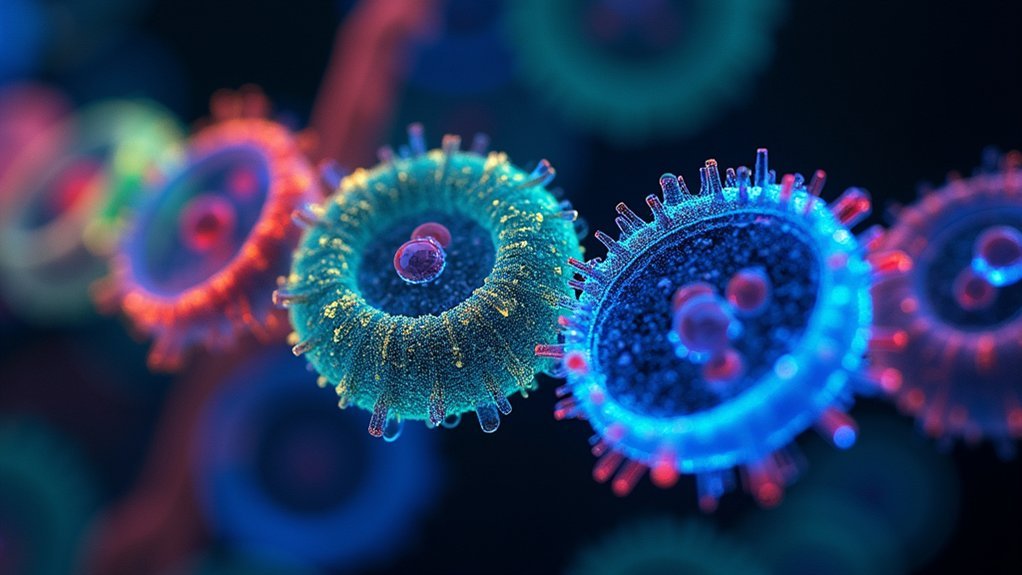
You’ll find essential dyes indispensable for evaluating cell viability through their selective permeability across intact versus compromised membranes, with trypan blue and calcein-AM serving as classic examples.
These specialized stains let you monitor living cells in real-time, distinguishing metabolically active cells from dead ones based on enzymatic activity and membrane integrity.
Organelle-specific essential dyes such as Hoechst 33342 for nuclei and MitoTracker for mitochondria allow you to visualize distinct subcellular structures without greatly compromising cellular function.
Cell Viability Assessment
When studying cellular processes, distinguishing between living and dead cells is essential for accurate experimental interpretation. For cell viability assessment, you’ll find crucial dyes particularly effective when used with contrast imaging techniques.
Trypan blue selectively stains dead cells blue while leaving viable cells colorless, providing immediate visual feedback during live cell imaging.
- Calcein-AM offers superior detection through fluorescence microscopy, as it converts to green-fluorescent calcein only in metabolically active cells.
- Combining crucial dyes with phase contrast enhances cellular morphology visualization without disrupting cell function.
- Dual staining approaches (using multiple dyes simultaneously) can differentiate between apoptotic and necrotic cell populations.
- For time-lapse studies, select low-toxicity dyes that won’t affect viability during extended imaging sessions.
Membrane Permeability Tracking
Tracking the integrity and permeability of cell membranes requires specialized essential dyes that won’t compromise cellular function during observation. When you’re monitoring live cells, crucial dyes like fluorescein diacetate (FDA) and propidium iodide (PI) offer valuable tools for evaluating cell viability in real-time.
FDA penetrates viable cells, converting to fluorescent compounds internally, while PI only enters cells with damaged membranes.
For best results, combine these dyes with fluorescence microscopy techniques to enhance visualization of membrane permeability changes. You’ll achieve better contrast imaging by pairing crucial dyes with phase contrast or differential interference contrast methods, creating clearer distinctions between healthy and compromised cells.
This approach proves indispensable for drug testing, toxicity studies, and monitoring cellular responses to environmental stressors—all while maintaining cell viability throughout the imaging process.
Organelle Selective Staining
Visualizing specific organelles within living cells requires selective staining techniques that don’t compromise cellular viability. When you’re conducting live cell imaging, essential dyes like fluorescein diacetate (FDA) and rhodamine 123 allow you to observe cellular components in real-time without causing damage.
These dyes enhance resolution by targeting specific organelles based on their properties.
- Select dyes carefully—rhodamine 123 targets mitochondria based on membrane potential
- Pair organelle selective staining with fluorescence microscopy for superior contrast
- Minimize phototoxicity by choosing appropriate excitation wavelengths
- Combine specific probes like DAPI (nuclei) and LysoTracker (lysosomes) for detailed structural imaging
The integration of these essential dyes with advanced microscopy techniques greatly improves your ability to visualize intracellular structures with enhanced clarity and specificity during live cell observations.
Dark-Field Compatible Staining Methods
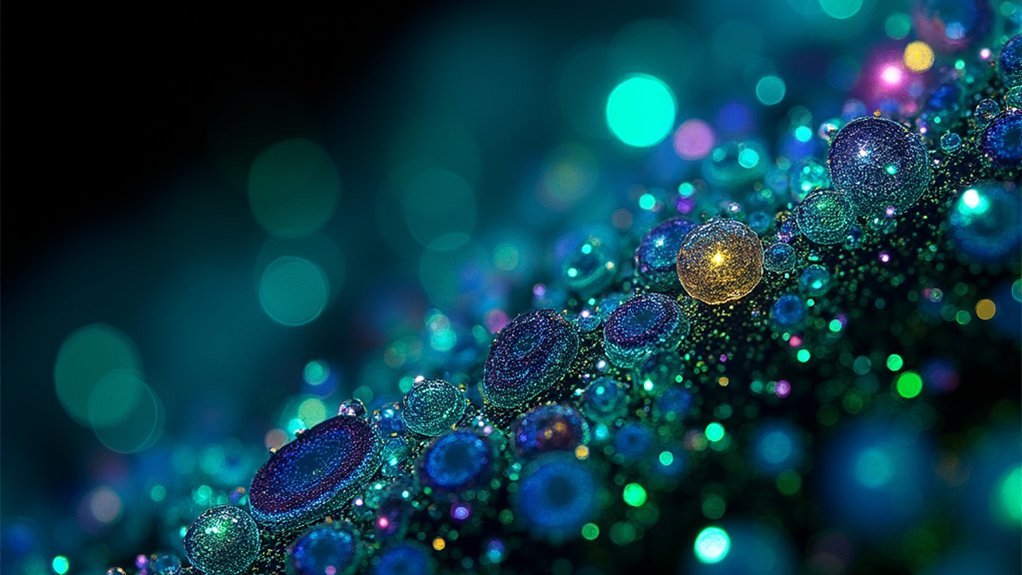
Although dark-field microscopy inherently enhances contrast without staining, combining this technique with specific stains can dramatically improve specimen visualization.
When you’re examining unstained bacteria, dark-field microscopy uses oblique illumination to detect surface details that might otherwise be invisible.
For best results, try negative staining with acidic dyes like India ink or nigrosin. These stains color the background while leaving microorganisms clear, creating striking contrast enhancement. This approach is particularly valuable in clinical settings where you need to identify pathogens quickly without compromising specimen integrity.
If you’re using traditional dyes like eosin or methylene blue, apply them sparingly. Too much stain can overwhelm the natural contrast advantages of dark-field techniques.
The right balance allows you to observe delicate cellular structures with remarkable clarity while preserving the distinctive illumination benefits of dark-field microscopy.
Capsule Highlighting Techniques for Bacterial Specimens
Building on the principles of negative staining mentioned above, capsule highlighting takes bacterial visualization to another level. You’ll find that capsule staining techniques reveal the polysaccharide structures surrounding bacterial cells that standard dyes can’t penetrate.
By applying negative staining agents like India ink or nigrosin, you’ll create a dark background that contrasts with the clear halo of the delicate capsule structure.
- Combine negative staining with positive stains like crystal violet to differentiate capsulated from non-capsulated bacteria
- Proper handling technique prevents disruption of capsules during preparation
- Visualization of capsules is essential for identifying virulent strains with immune-evasion capabilities
- The clear halo effect against the dark background provides definitive evidence of capsule presence
Digital Enhancement of Stained Specimens
When traditional staining reaches its limits, digital enhancement techniques take microscopic imaging to remarkable new heights. You’ll achieve superior contrast through background subtraction algorithms that average frames, eliminating noise while preserving critical specimen details.
Gram staining and acid-fast methods provide color differentiation that digital tools can further amplify, revealing precise bacterial morphology.
High-resolution cameras capture exceptional spatial detail when paired with quality staining techniques, while the system’s numerical aperture greatly impacts image clarity.
For thorough visualization, combine your staining techniques with differential interference contrast (DIC) or phase contrast microscopy—these methods highlight cellular structures through optical contrast variations that staining alone might miss.
The success of your digital enhancement depends on stain quality and concentration, ensuring ideal visualization of even the most challenging specimens.
Combining Multiple Stains for Complex Structures
To visualize intricate biological structures with thorough detail, you’ll need to master the strategic combination of multiple staining techniques. By combining multiple stains like Gram staining with endospore methods, you’ll reveal both cell structures and dormant forms simultaneously, considerably enhancing diagnostic accuracy.
- Pair acid-fast and negative capsule stains to highlight mycolic acid while revealing polysaccharide capsules in a single specimen.
- Implement positive and negative staining approaches together, such as India ink with safranin, to demonstrate both cellular components and surrounding capsules.
- Utilize Schaeffer-Fulton endospore staining with Gram staining to observe vegetative and dormant forms in the same preparation.
- Apply contrasting electron microscopy stains like uranyl acetate and lead citrate to enhance visibility of complex membrane structures.
The staining process becomes particularly powerful when you layer complementary techniques that target different cellular components.
Troubleshooting Common Staining Issues in Contrast Microscopy
Despite your best efforts, you’ll likely encounter staining problems that compromise image quality and interpretability. The staining procedure’s success begins with proper fixation—inadequate preparation leads to poor contrast and precipitation artifacts.
Pay close attention to your staining solutions’ pH; uranyl acetate works best at pH 3.5 for DNA binding, while deviations yield weak results.
Your rinse water’s quality matters greatly in the staining process. Remove CO₂ to prevent unwanted reactions that diminish contrast. Inconsistent solution concentrations frequently cause uneven staining, reducing specimen interpretability.
Maintain standardized protocols for reproducibility.
Consider automated staining techniques like the Leica EM AC20, which eliminate manual handling errors through pre-packaged solutions and precise condition control. These systems guarantee consistent results even when troubleshooting challenging specimens in contrast microscopy.
Frequently Asked Questions
Do Stains Increase Contrast?
Yes, stains definitely increase contrast. They’ll help you view cellular structures more clearly by adding color that differentiates between components. This enhanced visibility makes it easier for you to identify specific structures within samples.
What Staining Technique Is Most Commonly Used to Differentiate?
The Gram stain is your most commonly used bacterial differentiation technique. You’ll use crystal violet, iodine, alcohol decolorizer, and safranin to classify bacteria as either Gram-positive (purple) or Gram-negative (pink).
What Is the Relationship Between Contrast and Staining?
Staining and contrast share a symbiotic relationship: stains enhance cellular structures’ visibility by adding color differences, while contrast imaging techniques amplify these differences. You’ll see clearer microscopic details when they’re used together effectively.
What Is the Difference Between Simple and Differential Staining Which Is Better Suited for Common Clinical Microbiology Laboratory Applications?
Simple staining uses one dye for basic morphology, while differential staining uses multiple dyes to distinguish bacteria by characteristics. You’ll find differential staining better suited for clinical labs as it provides more diagnostic information.
In Summary
You’ve now explored the ideal staining techniques for contrast imaging. Remember, your choice depends on your specimen type and research goals. Whether you’re using Gram stains with phase contrast or fluorescent dyes for enhanced visualization, you’ll achieve better results by matching your staining protocol to your contrast method. Don’t hesitate to experiment with combinations and digital enhancement to overcome challenges and reveal complex structures in your microscopy work.

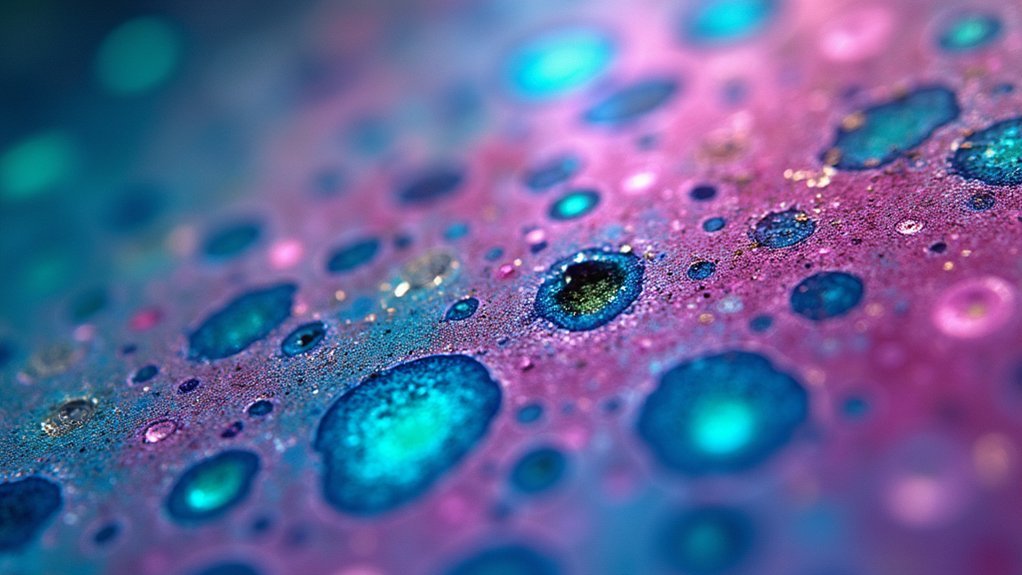



Leave a Reply